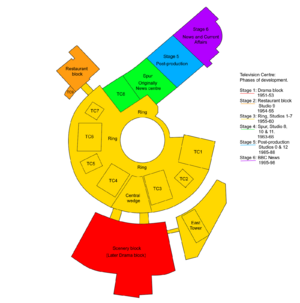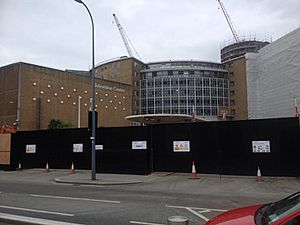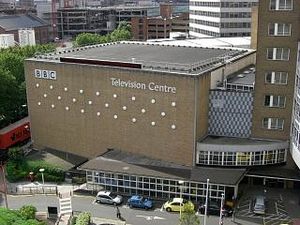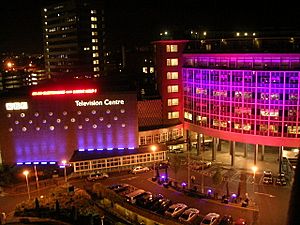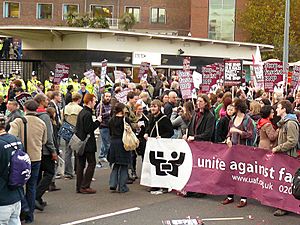Television Centre, London facts for kids
Quick facts for kids Television Centre |
|
|---|---|
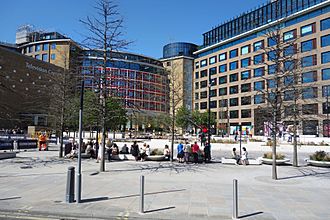
Television Centre in 2018
|
|
| Former names | BBC Television Centre |
| Alternative names | BBC Studioworks Television Centre |
| General information | |
| Type | Television production (1960–2013, 2017–present), mixed commercial and residential usage (2012–present) |
| Architectural style | Minimalist |
| Location | West side of Wood Lane (A219) in White City, opposite Wood Lane tube station |
| Address | White City, W12 7RJ |
| Country | England |
| Coordinates | 51°30′36″N 0°13′35″W / 51.5099°N 0.2263°W |
| Elevation | 6 m (20 ft) |
| Current tenants | BBC Studios BBC Studioworks |
| Completed | 29 June 1960 |
| Inaugurated | 29 June 1960 |
| Renovated | 2013–18 |
| Cost | £10 million adjusted by inflation: £87 million |
| Owner | BBC (1949–2013) AIMCo (2013–present) |
| Technical details | |
| Floor count | 8 (above ground) |
| Floor area | 14 acres (56,656 m2) |
| Design and construction | |
| Architect | Graham Dawbarn AHMM |
| Architecture firm | Norman & Dawbarn |
| Structural engineer | Marmaduke T. Tudsbery |
| Main contractor | Higgs and Hill (superstructure), George Wimpey (foundations) |
Television Centre (also known as TVC) is a famous building complex in White City, West London. For many years, from 1960 to 2013, it was the main home of BBC Television.
After being updated, the complex reopened in 2017. Now, three of its studios are used for making TV shows, managed by BBC Studioworks. The first BBC staff moved into one part of the building in 1953. The entire centre officially opened on June 29, 1960.
Television Centre is easy to recognise because it has been featured in many BBC programmes. Some parts of the building, like the central ring and Studio 1, are special because they are "Grade II listed." This means they are protected because of their historical or architectural importance.
Most of the BBC's national TV and radio news used to come from Television Centre. Live TV events and sports broadcasts also happened here. The building is about 4 miles (6.4 km) west of central London. You can get there by using the London Underground at White City or Wood Lane.
Contents
History of Television Centre
On April 1, 1949, Norman Collins, who was in charge of BBC Television, announced that a new TV centre would be built in Shepherd's Bush. At that time, London TV shows were broadcast from Alexandra Palace and Lime Grove Studios. The new centre was planned to be the biggest TV centre in the world.
The building was supposed to be 6 acres (2.4 ha) but ended up being twice that size. Work on the building started in 1950. However, the government put limits on building, so construction stopped until 1953. The BBC used other places like Lime Grove Studios and the Shepherd's Bush Empire for TV production in the meantime.
Building work started again in 1953 on the scenery block. In 1954, work began on the canteen block, which was also used for rehearsals. Construction on the main circular office block and studios began in March 1955.
BBC Television Centre officially opened on June 29, 1960. The first show broadcast from the new centre was First Night with David Nixon in Studio Three.
In 1997, the BBC News Centre opened in a new part of the building. This is where BBC News programmes were made.
Changes and Redevelopment
In 2007, the BBC announced that it would sell Television Centre to save money. The plan was to sell the building by 2013. A BBC spokesperson said they would not rent it back. The building was officially put up for sale in June 2011.
Some BBC departments, like BBC Sport and BBC Children's, moved to MediaCityUK in Salford Quays in 2012. This move meant about 1,500 jobs from Television Centre moved to Salford. BBC Breakfast also moved there in April 2012.
On July 16, 2012, the BBC agreed to sell the site to Stanhope for £200 million. The building closed on March 31, 2013. It was then redeveloped to include apartments, offices, a cinema, and hotels.
Studios 1, 2, and 3, along with some offices, were renovated and rented back to the BBC for 15 years. The BBC's commercial business, BBC Studios, also rents office space in the building.
All BBC News, national radio, and BBC World Service broadcasts moved to Broadcasting House in central London between 2012 and 2013. The last news broadcasts from Television Centre happened on March 18, 2013.
A documentary called Tales of Television Centre was shown on BBC Four in 2012. On March 22, 2013, BBC Four had an evening of programmes celebrating Television Centre. The last live show broadcast from the building was Madness Live: Goodbye Television Centre.
In March 2013, the BBC and Stanhope worked together to manage the redevelopment of the 14-acre site. Only three of the eight production studios were kept for the BBC. The other studios were taken down to make way for apartments.
Demolition work began in February 2015. By April 2016, only Studios TC1, TC2, and TC3 remained. The famous statue of Helios was removed for cleaning and returned later in 2016.
Reopening of Studios
BBC Studioworks, a part of the BBC, now runs Studios 1, 2, and 3 and the production facilities at Television Centre. The newly updated studios officially opened on September 1, 2017.
The first live programme from the reopened studios was Strictly Come Dancing: It Takes Two on BBC Two on September 25, 2017.
In April 2018, ITV's daytime shows like Good Morning Britain, Lorraine, This Morning, and Loose Women moved to Television Centre. This happened because their old studios, The London Studios, were closing for redevelopment. ITV decided to stay at Television Centre.
On June 29, 2020, Television Centre turned 60 years old. The Royal Television Society celebrated this with a special programme.
The Building's Design
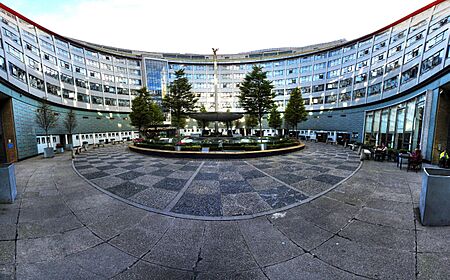
Unique Shape and Features
From above, the entire building looks like a question mark. The architect, Graham Dawbarn, drew a question mark on an envelope and realised it would be a perfect shape for the site.
The building has a central circular block, often called the "doughnut" by staff. Around this block are the studios, offices, and the News Centre.
The Helios Statue
In the middle of the main circular block is a statue of Helios, the Greek god of the sun. It was designed by T. B. Huxley-Jones. The statue is meant to show how television waves spread around the world. At the bottom of the statue are two figures representing sound and vision, which are the two parts of television.
The statue was originally a fountain, but it was too noisy for the offices nearby. There were also problems with water leaking into the area below.
Arthur Hayes designed the original 'BBC Television Centre' lettering on the outside of Studio 1. This lettering was later used throughout the building. He also created the famous 'Atomic Dots' on the outside of Studio 1. There are 26 of these dots, and they light up at night.
Over the years, the building was expanded many times. Even with these additions, the BBC had to find more space elsewhere, like the nearby BBC White City complex.
Protected Status
In 2008, English Heritage asked for parts of Television Centre to be given "listed status." This would protect the building because of its special history and design.
On June 17, 2009, the Central Ring of the building and Studio 1 were given Grade II listed status. This means they are protected. Important features include the John Piper mosaic, the central drum with its mosaic tiles, the Helios statue, and the original clock. The 'atomic dots' and the name of Studio 1 were also noted as important.
The architecture minister, Barbara Follett, said that the building was where famous shows like Doctor Who, Fawlty Towers, and Blue Peter were made.
Television Studios
Currently, and in its later years, the studios at Television Centre were run by BBC Studioworks. The studios vary in size and are usually called by initials, like TC1 for Studio 1.
These studios have hosted many different TV shows for various broadcasters. Before 2013, famous shows like Strictly Come Dancing, Match of the Day, and Blue Peter were made here. Classic BBC shows like Fawlty Towers, Monty Python's Flying Circus, and the original Doctor Who series were also filmed at the site.
From the 1980s, fewer drama series were filmed here. This was because drama shows started using film or single-camera video more, and Television Centre was set up for video-based, multi-camera productions.
- Studio 1 - 10,250 sq ft (952 m2) - Opened in April 1964, it was the fourth largest TV studio in Britain. It was one of the studios set up for HDTV (High Definition TV) production.
Programmes recorded or transmitted here include:
- Sounds Like Friday Night
- The Graham Norton Show
- Ant & Dec's Saturday Night Takeaway
- The Jonathan Ross Show
- The Russell Howard Hour
- Blind Date
- BBC Radio 1's Teen Awards
- The Last Leg
- Studio 2 - 2,400 sq ft (220 m2) - Opened in late 1960. This studio was home to many comedy shows. It was used by BBC News until 1997 and also hosted shows for Sports and Children's departments. It was the main studio for Blue Peter in 2007 and 2008. Studio 2 is now home to ITV programmes like Lorraine, Loose Women, and Peston, as well as Channel 4's Sunday Brunch.
- Studio 3 - 6,390 sq ft (594 m2) - Opened on June 29, 1960. It was designed for drama productions. The walls were made thicker to block noise from the London Underground lines nearby. It was the first studio to be completed and was updated for colour TV in 1969. Studio 3 now broadcasts ITV programmes Good Morning Britain and This Morning. It also hosted part of the Eurovision Song Contest 1963.
Former Studios at Television Centre
- Studio 0 - 1,260 sq ft (117 m2) - Opened in 1989 as a music studio. It later became a control room. Shows for UK Play and virtual reality programmes were made here. It was home to Liquid News and CBeebies in-vision continuity.
- Studio 4 - 6,300 sq ft (590 m2) - Opened in January 1961. It was designed for light entertainment shows. Programmes like Top of the Pops and Strictly Come Dancing were recorded here.
- Studio 5 - 2,400 sq ft (220 m2) - Opened in August 1961. It was first used for BBC Schools programmes. After being updated, it hosted sports shows like Match of the Day until 2011, when the Sports department moved to MediaCityUK.
- Studio 6 - 6,440 sq ft (598 m2) - Opened in July 1967, at the same time BBC Two switched to colour. It was the first studio equipped for colour production. Children's programmes like Live & Kicking and Pointless were recorded here.
- Studio 7 - 2,400 sq ft (220 m2) - Opened in 1962. Early children's programmes like Play School were recorded here. After 1997, BBC News used it for shows like BBC Breakfast and BBC News at Six. News broadcasts from this studio ended in 2013.
- Studio 8 - 6,480 sq ft (602 m2) - Opened in 1967. It was considered a great studio for its size. It mainly broadcast comedy shows, sitcoms, and quiz shows like Miranda and Tipping Point. It was the first studio converted for HDTV production in 2007.
- Studio 9 - 900 sq ft (84 m2) - Built in 1955 as a restaurant foyer, it became a studio in 1996 for CBBC. Programmes like Sam & Mark's TMi Friday were recorded here.
- Studio 10 - 1,200 sq ft (110 m2) - Opened in 1969 for BBC1 daytime news. It was also home to BBC World. It closed in 1999 and was later used for CBBC and CBeebies programmes.
- Studio 11 - 2,000 sq ft (190 m2) - Opened in 1969 for BBC2 daytime news. It later became home to the Six O'Clock and Nine O'Clock News. After the news moved out in 1999, it hosted shows like Liquid News and Strictly Come Dancing: It Takes Two. It closed in 2011.
- Studio 12 - 600 sq ft (56 m2) - Originally a control room, it became a studio in 2004 for CBBC programmes. It was also used for Sportsround and later became a presentation studio for CBBC.
- Pres A - 704 sq ft (65.4 m2) - Opened in 1960 for BBC 1 in-vision continuity. It became the weather studio and later a full-time home for Children's BBC. It closed and was converted into control rooms.
- Pres B - 704 sq ft (65.4 m2) - Opened in 1964 for BBC 2 in-vision continuity. It hosted small productions like Points of View and The Old Grey Whistle Test. It closed in 1996 and was also converted into control rooms.
News Studios
BBC News used several studios for its frequent news bulletins. These studios had a different naming system. They were located in the BBC News Centre. After redevelopment, this area became the new home for BBC Studios.
Recent Productions at Television Centre
BBC Shows
- BBC Radio 1 Teen Awards (TC1: Nov 2019)
- The Graham Norton Show (TC1: 2018–present)
- Later... with Jools Holland (TC1: 2019–present)
- Mock the Week (TC1: 2018–2022)
- QI (TC1: 2019–present)
- Sounds Like Friday Night (TC1: 2017–2018)
- Strictly Come Dancing: It Takes Two (TC2: 2017)
- Top Gear (Central Courtyard: 2021–2022)
ITV Shows
- The Chase (TC1: Celebrity Specials, 2019)
- Good Morning Britain (TC3: 2018–present)
- The Jonathan Ross Show (TC1: 2017–present)
- Loose Women (TC2: 2018–present)
- Lorraine (TC2: 2018–present)
- This Morning (TC3: 2018–present)
- Peston (TC2: 2018–present)
- Ant & Dec's Saturday Night Takeaway (TC1: 2020—2024)
Other Productions
- The Big Narstie Show (TC1: 2018–present)
- Blind Date (TC1: 2017–2018)
- El Hormiguero (TC1: Special, 2019)
- The Great British Bake Off: An Extra Slice (TC1: 2018–present)
- The Russell Howard Hour (TC1: 2017–present)
- Sunday Brunch (TC2: 2019–present)
- The Last Leg (TC1: 2018–2021)
- Your Face or Mine? (TC1: 2019–present)
Major Events at Television Centre
Incidents and Power Cuts
On March 4, 2001, a bomb exploded outside the news centre. No one was killed, and the building was repaired.
Television Centre has had power cuts that affected broadcasting. One power cut caused the launch night of BBC2 on April 20, 1964, to be cancelled.
A major power failure happened on June 20, 2000, affecting the entire Television Centre. Services like BBC One, BBC Two, and BBC Radio 4 went off air or changed their schedules. The Six O'Clock News had to be cancelled. The BBC's backup generator also caught fire. Normal services returned the next day.
On November 28, 2003, an electrical fault caused equipment to overheat, setting off fire alarms. This led to widespread power cuts. News programmes had to broadcast from other studios across London.
Protests at the Centre
Sometimes, protests have interrupted programmes at Television Centre. In 1988, a group of protestors entered the studio of the Six O'Clock News during a live broadcast.
On May 20, 2006, during the live show National Lottery: Jet Set, protestors entered the studio. The show briefly went off air while they were removed.
On October 22, 2009, there were strong protests outside the studios because the BBC invited a controversial political leader onto the programme Question Time. Some protestors managed to get into the reception area. Police and security had to close gates and form barriers.
On August 9, 2021, some protestors tried to get into Television Centre. However, the BBC's news operations had already moved out in 2013. Police were there to stop them from entering BBC Studioworks. Some protestors later marched to Broadcasting House, where BBC News is now based.
See also
 In Spanish: BBC Television Centre para niños
In Spanish: BBC Television Centre para niños


